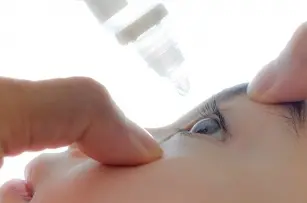Contents

Do you ever feel like there is a layer of sand under your eyelids? Or maybe you feel something that can be called the feeling of heavy eyelids? Perhaps your eyes don’t produce enough tear film, resulting in dry eye syndrome.
What is dry eye syndrome?
Feeling a burning sensation, feeling that there is sand under the eyelid, red eyes or itching can be a symptom of an eye condition such as conjunctivitis, but more often they indicate the so-called dry eye syndrome.
Dry eye is diagnosed by an ophthalmologist. Usually a simple test is used for this. The doctor inserts a special strip under the lower eyelid, thanks to which he will check how many tears will accumulate during the examination. After 5 minutes, it can read the measurement. If the measurement shows less than 15mm of fluid, it means that our eye is not producing enough fluid.
What are our tears?
Naturally, our eyes produce a tear film throughout the day. It is a layer of our tears that moisturizes and protects the delicate surface of the eye. A person begins to produce tears after the first month of life. They provide a protective barrier against dust, bacteria and mechanical injuries.
We all know that tears are salty, so they must be made up of water and salt. However, that’s not all. The eye is a very complex organ. It is very delicate, and it is protected by the so-called tear film, which in fact consists of as many as three layers of substances:
- Lipid layer – outer, consists of fat, which prevents tears from evaporating from the surface of the eye.
- water layer – middle, nourishes and moisturizes the eye.
- Mucin layer – inner, makes the tear film adhere to the surface of the eye.
The tear film is therefore not only water and salt, but also fats and appropriate proteins.
What is it caused by?
If there are too few tears or they have the wrong composition and do not provide adequate hydration eyes sting, tear, there is redness and general discomfort. Dryness of the eye can also cause pain in the eyeball, and even lead to damage to the cornea and the inside of the eyelids.
Tear dysfunction can be caused by:
- Allergies.
- Staying in heated or air-conditioned rooms.
- Malfunction of the meibomian glands, which clog up and prevent tears from flowing out.
- Working on a computer monitor.
- Wearing contact lenses.
- Convalescence period after ophthalmological procedures.
Dry eye syndrome is the most common eye disease. The eyes are tired, bloodshot and watery. It is not a health-threatening ailment, but it affects the reduction of our comfort of life and the quality of vision. Diagnosis should take place in the office of an ophthalmologist to rule out other conditions, such as the aforementioned conjunctivitis. The doctor will examine the amount and quality of the tear film that the eye produces and make a diagnosis.
Artificial tears for dry eye
Dry eye it’s a common ailment and certainly in our close environment we are not the only ones suffering from it. Therefore, there are a number of preparations and drops available on the market that will help to deal with it. It is important to choose the right drug for our needs. It is worth paying attention to the composition and consistency. The simplest solution may seem to be the use of saline, because it contains what our tears have: water and salt. However, tears are not just these two ingredients, and saline is not the right preparation.
Drops that are used in the case of dry eye syndrome are colloquially called “artificial tears”. They can contain many moisturizing substances, but it is best to use those that imitate the natural substances of our body as much as possible. Preservatives can be found in many drops. These are safe agents that ensure that the drops are suitable for use on the surface of the eye, but many people have allergic reactions to converting substances. Preservatives can also damage the surface of contact lenses. Therefore, the best solution are artificial tears without preservatives, and sold in disposable and thus hygienic ampoules.
The best artificial tears are those that will mimic the behavior of the tear film and provide additional protection. Such drops are, for example, Bepanthen Eye eye drops with hyaluronic acid. Hyaluronic acid it is present here in the form of sodium salt, which, thanks to its high viscosity, stays on the surface of the eye longer, just like a tear film. It is a substance naturally produced by the human body in the skin, joints and eyes. These drops also contain provitamin B5, which has the ability to bind water, and therefore have a double moisturizing power. Thanks to the fact that these eye drops are preservative-free, they can be safely used by contact lens wearers.









